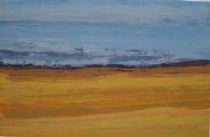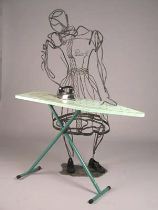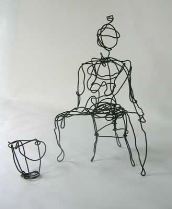[Note: artblog editors have paired these two posts about Highwire’s current show to expedite their posting.]

Post by Aly Gibson
Highwire Gallery’s current two-person exhibit includes Antonio Grimaldi’s brilliant colored landscape paintings which light up the room and Kt Carney’s life-size sculptures of average, working class Americans. I especially enjoyed the latter. (image is Grimaldi‘s “Rumbling Clouds,”)
Carney creates her sculptures using steel, wire and in some cases, found objects. She accompanies each sculpture with the subject’s obituary to show her viewers that although these people led seemingly insignificant lives, they were content, passionate about their work and cherished by those who knew them. Carney succeeds in showing appreciation for individuals we rarely notice.
–Aly Gibson is a student in Colette Copeland’s art writing class at the University of Pennsylvania
Post by Elizabeth Yohlin
The inspiration for Kt Carney’s steel gestural sculptures of deceased individuals engaging in their favorite tasks comes from actual obituaries, from which the artist creates identities for the deceased based on their described attributes. Her sculptures are poignant memorials, which evoke a fondness for the subjects and create an awareness that ultimately the memory of every person will be characterized by the mundane.

Particularly noteworthy are the portrayals of Elizabeth Atzert and Pearl Buzarth. Elizabeth, a ribbon maker, is playfully seated on the floor with outstretched arms and legs. A long red ribbon is gracefully draped over her arms, providing an interesting contrast to the gnarled steel that comprises her form.
Pearl is an especially significant presence among the sculptures, as she towers over the viewers. Her name, crafted in steel is inscribed upon her maid uniform. Her dress is skillfully constructed, emphasizing the pleats in her skirt and depicting the geometric forms that are the foundation of real objects.

Pearl’s obituary hangs on the wall next to her and reads: “She was known for the lovely ironing work she did.” Thus, she hovers over an actual ironing board, her sculpted hand clutching a real iron.
The juxtaposition between found objects and the sculptural apparitions of the deceased alludes to the permanence of objects, despite the demise of people.
–Elizabeth Yohlin is a student in Colette Copeland’s art writing class at the University of Pennsylvania









